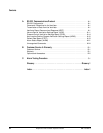
Chapter 2
Warnings, Cautions, and Notes
REF 1057983 A Respironics V200 Ventilator Operator’s Manual 2-3
• When using the Remote Alarm Port be sure to fully test the
Remote Alarm Port and cable by:
• Verifying that annunciated alarms on the ventilator are also
annunciated on the remote alarm.
• Verifying that disconnecting the cable from the Remote. Alarm
port results in an alarm notification at the Remote Alarm.
• Verifying that disconnecting the cable from the remote alarm
results in an alarm notification at the Remote Alarm.
• Ensure that an alternative means of ventilation (that is, a
resuscitator or similar device) is available while the ventilator is in
use on a patient.
• The ventilator complies with the requirements of IEC 601-1-2
(EMC collateral standard), including the E-field susceptibility
requirements at a level of 10 volts per meter. However, even at
this level of immunity, certain transmitting devices (cellular
phones, walkie-talkies, etc.) emit radio frequencies that could
disrupt ventilator operation if operated in a range too close to the
ventilator.
• DO NOT operate the ventilator in a Magnetic Resonance Imaging
(MRI) environment.
• Vent Inop is a serious condition, which is indicated by both visual
and audible alarms. If the ventilator is attached to a patient when
Vent Inop occurs, the patient must be supported with another
means of life support ventilation.
• When the battery low indicator is flashing red, operation of the
ventilator from battery power should be discontinued.
• For patient safety the HIP Limit Setting should be set as close to
the peak inspiratory pressure as patient conditions allow.
• DO NOT perform the preoperational procedure when the ventilator
is on a patient.
• You will be warned if the compliance is 9.0 ml/cmH
2
O (hPa) or
larger. Patients should not be put on a patient circuit that does
not meet this requirement.
• A high priority, visual and audible alarm indicates a potentially
life-threatening condition and immediate response is required.
• When the safety valve open indicator is lit, the ventilator does not
provide any ventilatory support to the patient. Immediately use a
backup means of ventilatory support.
• Visually monitor the patient and ventilator during the Alarm
Silence period to ensure that alarms do not go undetected.
Allowing alarm conditions to continue without intervention may
result in harm to the patient and/or ventilator.
• Do not expose expiratory and inspiratory bacteria filters or
reusable patient tubing to ETO gas.


















